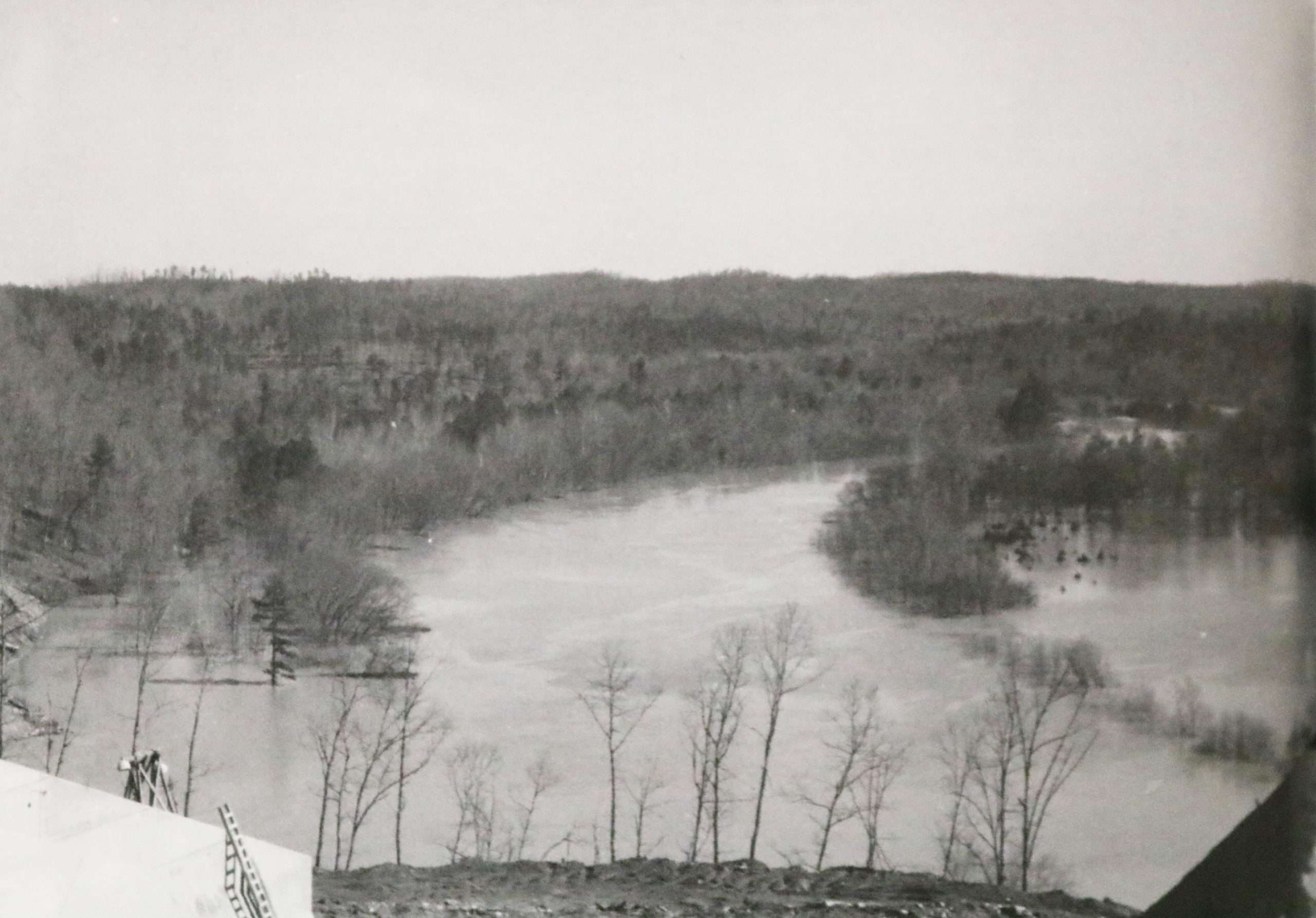Early history of lake, dam began with securing funding, selecting site
This the first article in a series relating the history of Lake Lanier and Buford Dam and coinciding with a special exhibit on Lake Lanier presented by the Sugar Hill Historic Preservation Society at the city’s history museum through Aug. 23.
With all of the recent publicity surrounding Lake Lanier, it is hard at times to distinguish what is factual about the lake. Videos are appearing on YouTube and TikTok making claims about the origins of the lake and even about why so many people die on the lake, which is the most visited lake of any that the U.S. Army Corps of Engineers operates in the nation. Lake Lanier sees approximately 11.8 million people visit the 692 miles of shoreline each year.
Research has been done by individuals passionate about sharing the facts of the lake with the public. One such person is Robert David Coughlin, author of “Lake Sidney Lanier ‘A Storybook Site’: The Early History & Construction of Buford Dam.” The 440-page book explores the early history and construction of Buford Dam, including why the lake was constructed and why the location was chosen.
Coughlin recently gave a presentation at an event hosted by the Sugar Hill Historic Preservation Society at the Sugar Hill History Museum. He was able to talk about the early years of Lake Lanier and the reasons why the lake was constructed, why the site of the dam and lake was chosen, the relocation of families with property in the way of the lake and the construction of the dam.
In the 1940s, officials began talking about building a major reservoir on the Chattahoochee River north of Atlanta. The new reservoir was to help flood control, generate electricity, provide a reliable water supply, help navigation downstream and, lastly, provide recreation.
Supporters of building the new reservoir had to take the battle to the U.S. Capitol Building and convince Congress to fund the project. In 1949, Atlanta mayor William Berry Hartsfield took a contingent of prominent north Georgians, including H. Paul Dover, Weldon Archer, H. Jack Turner and Stanley Allen, from Buford to Washington, D.C., to testify before a Senate subcommittee on appropriations. Several members of Congress from Georgia kept fighting for the funding needed for the project. Local everyday residents were also instrumental in getting the project funded, including Buford insurance agent Weldon Gardner; Buford City Manager Jack Turner; Buford City Schools Superintendent A.I. Clark; and Buford lawyer Joe Cheeley. In total, the Buford Dam and Lake Sidney Lanier project cost close to $45 million, which would be an equivalent of nearly $450 million today.
Two sites were considered for the placement of the dam for the new reservoir along the Chattahoochee River. In the original proposal, the U.S. Army Corps of Engineers had the site of the dam for what would be the northernmost dam on the Chattahoochee River at Roswell. However, in 1946, the proposal was redone with the site of the dam to be at Buford instead.
The proposal cited that the dam being constructed at Roswell would require the relocation of more families and infrastructure, including highways and railroads, which would be far more expensive than building the dam at Buford. Also a major concern was having adequate and steady flow of water at Morgan Falls, a Georgia Power hydroelectric plant just south of Roswell. The plant was not designed to handle the variable flow that would result from construction of a dam at Roswell.
Buford was chosen as the site for the construction of the new dam. Buford and the area to the north that would be impacted by its construction were primarily rural farm land during the 1940s and 1950s. No incorporated towns or cities would be impacted, however, smaller communities would be. Construction at Buford would impact 250 families, far fewer than at Roswell. The river bed and surrounding topography was ideal for the construction of the dam and powerhouse structure and subsequent earthen dam.
The acquisition of land parcels began in 1954 and lasted several years. Hundreds of families, both black and white, were forced to move, six churches and 20 cemeteries were relocated, 15 businesses had to move or close, bridges and other infrastructure in the area were covered over with water along with thousands of acres of forest land. In total, more than 50,000 acres were purchased from the residents of Hall, Gwinnett, Forsyth, Dawson and Lumpkin counties.
Mr. H. E. Shadburn was the first person to sell his land to the U.S. Army Corps of Engineers to make way for the reservoir. He owned 99.24 acres in Forsyth County that records described as “undulating on bottom land to medium rolling on some of the cultivable land.” Shadburn sold his property on April 13, 1954, for the price of $4,100.
This acquisition process lasted years, along with the relocation of structures, graves and more, continuing past the time the dam’s construction was complete. When the lake reached a certain depth, crews went around the lake with saws and cut the trees at the water line, so vast areas of forest still stand underwater, some trees 80 feet tall remain standing. Structures such as brick or stone buildings including a stone home, a brick gas station and the Looper racetrack all remain under the waters of Lake Sidney Lanier.
Once the land was acquired, construction could begin on the actual dam.
The next articles in this series exploring the history of Buford Dam and Lake Lanier will dive into the ground breaking ceremony, construction of the saddle dikes and spillway, the forebay excavation and intake construction, construction of the earthen dam and the relocation of bridges and highways impacted by the project.
Growing up around Lake Lanier instills respect for what lies beneath
For many local residents, growing up in Buford was synonymous with growing up on Lake Lanier. This rang true for myself and many of my friends as we were growing up in the ’80s and ’90s in Buford and Sugar Hill. The lake provided us with endless summers of fun in the sun, countless memories made, lessons learned and legends heard.
As far back as I can remember, I had memories that included Lake Lanier or the Chattahoochee River. In my mind I see snippets of views of the lake from Buford Dam, the campsite we camped at one summer, worms and fishing poles, my friend’s pontoon boat, dead fish, the swings at West Bank Park, me riding on a tube being pulled behind a boat and enjoying the waterpark at the Islands.

Every summer involved my family, friends and myself and the lake in some capacity. For years, my mother got us season passes to the Lake Lanier Islands waterpark, which is now known as Margaritaville. We spent our whole summer playing in that park. I remember getting so tan and for someone like me, that is a lot of time spent in the sun to accomplish that as I am on the pale side.
I had family and friends with boats, so my sister, my friends and I learned at an early age how to navigate the lake, what dangers to watch out for, the general boating rules and so on. I am by nature a competitive person. One summer day when I was about 12 years old, my friends and I went out on their boat. We spent the day tubing on the lake. This was no leisurely activity where you are just being pulled around on the tube at a sedate pace. No, this was my friend’s family trying their absolute best to knock us off the tube.
Person after person was getting thrown off the tube into the middle of the lake. We were all teasing one another in good fun. It was my turn and being the smallest of my group, I had an unfair advantage that I capitalized on. Being so short, I have always been able to wedge myself inside of the tube.
I swam out to the tube, hoisted myself up onto it, got myself wedged tightly inside and signaled that I was ready to let the fun begin. We were off and I was being slung back and forth behind the boat as the driver would jump the waves made by other boats passing by and they would make sharp turns that would rapidly cause your tube to glide across the water.
After one particularly crazy stunt by the driver where he hit a wave as he was turning, I went airborne in the tube. The driver slowed the boat down and started circling back to locate me in the water. Imagine their shock when they realized I was still inside the tube. The looks on their faces were priceless and I felt so smug that I never got knocked out of the tube.
I had plenty of motivation not to want to end up in the middle of the lake by myself waiting on the boat to come back for me. I grew up listening to older generations talk about the lake. They told me about the lake being built, what was torn down, what was left under the lake, people who had gone missing around the lake and about the giant catfish lurking in its depths. I was told about the relocation of the cemeteries and how there were small family cemeteries where graves were not marked so the government didn’t know to move those graves.
Even with those tales, I still managed to enjoy my time spent at the lake. I just spent most of my time on a boat or a float. If I was stuck in the middle of the lake without a float, I wiggled the entire time praying the giant fish or who knows what else didn’t come up from the depths to mess with me.
As a kid, our imaginations ran wild, so after listening to men like Glad Sudderth talk about the lake, it’s no wonder I was afraid that something was coming up from the depths to bite me in the rear.
Looking back on my time spent on the lake, I realize just how much I learned. Many of the natives of the area around the lake were taught from an early age to respect the lake. It’s beautiful and fun but deceptive. One can quickly go from having the time of their lives to fighting for their life.
Each year that passes, I read about more and more drownings on the lake. I have realized that the people who drown are not from around here. They get out on the lake, underestimate it and then get in trouble.
Natives learn how to tell the depth of the water just by looking at its color. We know the lake can go from four feet of water to well over 20 feet in a flash. We know about what lies beneath the surface, like trees and fishing lines. We also know that it may look like a short swim across the cove or to that island, but in fact, it is quite a clip away. We know to wear a life jacket if out in water over our heads. One would rather look a bit dorky now than to never see another day.
Lake Lanier was a wonderful place to spend our summers growing up. It still is, so long as one respects the lake.




